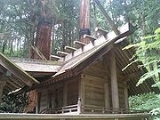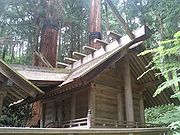
Nishina Shinmei Shrine
Encyclopedia

Omachi, Nagano
is a city located in Nagano, Japan.As of 2008, the city has an estimated population of 31,079 and the population density of 55 persons per km². The total area is 564.99 km²....
, Nagano Prefecture
Nagano Prefecture
is a prefecture of Japan located in the Chūbu region of the island of Honshū. The capital is the city of Nagano.- History :Nagano was formerly known as the province of Shinano...
, Japan
Japan
Japan is an island nation in East Asia. Located in the Pacific Ocean, it lies to the east of the Sea of Japan, China, North Korea, South Korea and Russia, stretching from the Sea of Okhotsk in the north to the East China Sea and Taiwan in the south...
. The shrine is the oldest extant example of shinmei-zukuri
Shinmei-zukuri
is an ancient Japanese architectural style typical of Ise Grand Shrine's honden, the holiest of Shinto shrines. It is most common in Mie prefecture.-History:...
, one of three architectural styles which were conceived before the arrival of Buddhism in Japan
Buddhism in Japan
The history of Buddhism in Japan can be roughly divided into three periods, namely the Nara period , the Heian period and the post-Heian period . Each period saw the introduction of new doctrines and upheavals in existing schools...
. It predates in fact the more famous Ise Shrine
Ise Shrine
is a Shinto shrine dedicated to goddess Amaterasu-ōmikami, located in the city of Ise in Mie prefecture, Japan. Officially known simply as , Ise Jingū is in fact a shrine complex composed of a large number of Shinto shrines centered on two main shrines, and ....
, which shares the style and has been since antiquity rebuilt every twenty years.
This style is characterized by an extreme simplicity. Its basic features can be seen in Japanese architecture from the Kofun period
Kofun period
The is an era in the history of Japan from around 250 to 538. It follows the Yayoi period. The word kofun is Japanese for the type of burial mounds dating from this era. The Kofun and the subsequent Asuka periods are sometimes referred to collectively as the Yamato period...
(250–538 C.E.) onwards and it is considered the pinnacle of Japanese traditional architecture. It is most common in Mie prefecture
Mie Prefecture
is a prefecture of Japan which is part of the Kansai regions on Honshū island. The capital is the city of Tsu.- History :Until the Meiji Restoration, Mie prefecture was known as Ise Province and Iga Province....
. Built in planed, unfinished wood, the honden
Honden
The , is the most sacred building at a Shinto shrine, intended purely for the use of the enshrined kami, usually symbolized by a mirror or sometimes by a statue. The building is normally in the rear of the shrine and closed to the general public. In front of its usually stands the haiden, or...
is either 3x2 ken
Ken
Ken or KEN may refer to:*Ken meaning "prefecture" in Japanese - see Prefectures of Japan*Ken , 1964 Japanese film*Kèn from Vietnam*Komisja Edukacji Narodowej, Polish National Board of Education...
or 1x1ken in size, has a raised floor, a gabled roof with an entry on one the non-gabled sides , no upward curve at the eaves, and purely decorative logs called chigi
Chigi (architecture)
, or are forked roof finials found in Japanese and Shinto Architecture. Chigi predate Buddhist influence and are an architectural element endemic to Japan. They are an important aesthetic aspect of Shinto shrines, where they are often paired with katsuogi, another type of roof ornamentation...
(vertical) and katsuogi
Katsuogi
or are short, decorative logs found on Japanese and Shinto architecture. They are placed at a right angle along the ridge of roofs, and are usually featured in religious or imperial architecture. Katsuogi predate Buddhist influence and is an architectural element endemic to Japan. They are...
(horizontal) protruding from the roof's ridge.
Two of its structures, the and the , are listed as National Treasures of Japan
National treasures of Japan
National Treasures are the most precious of Japan's Tangible Cultural Properties, as determined and designated by the Agency for Cultural Affairs...
.

